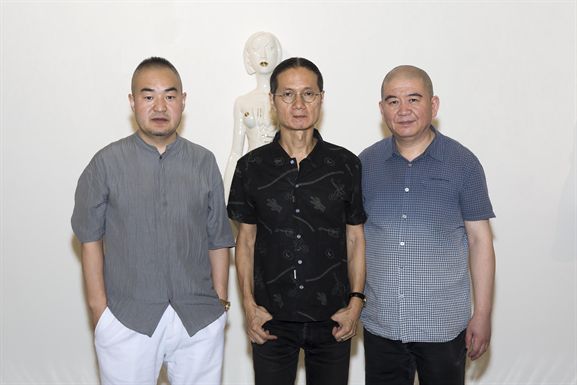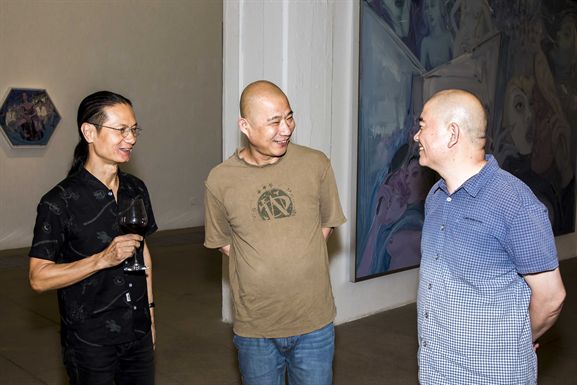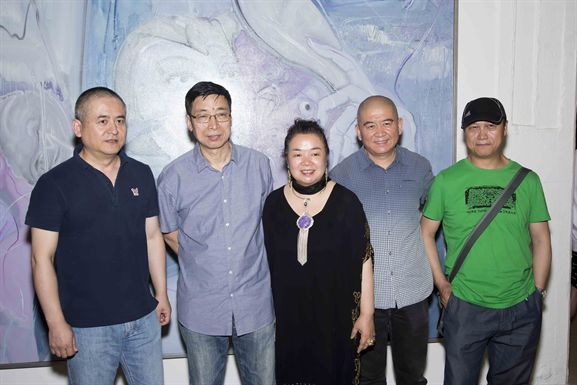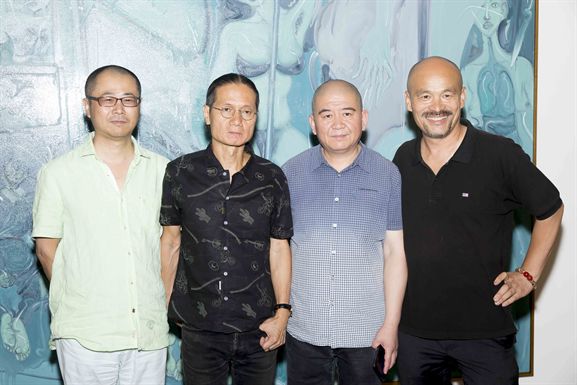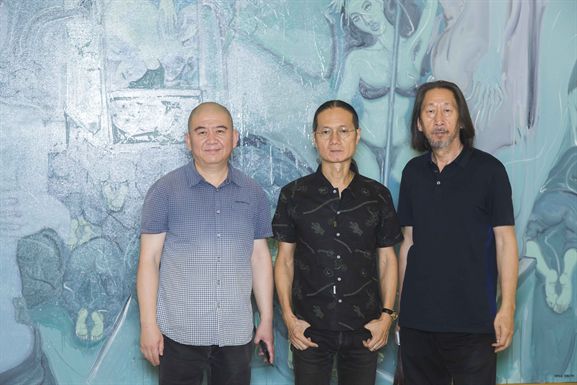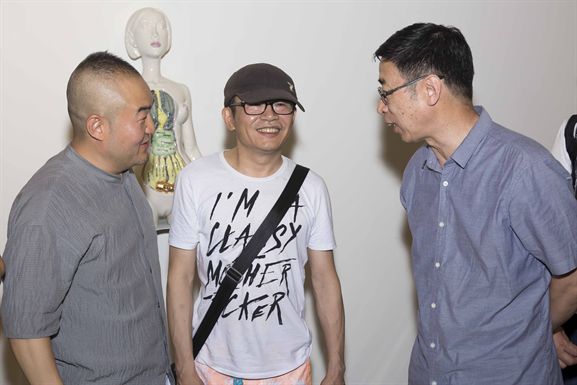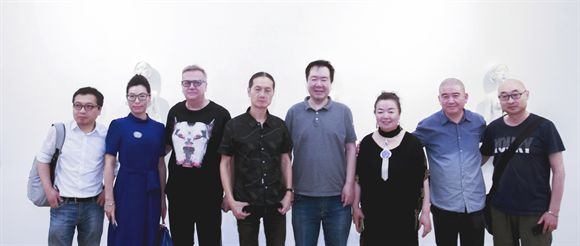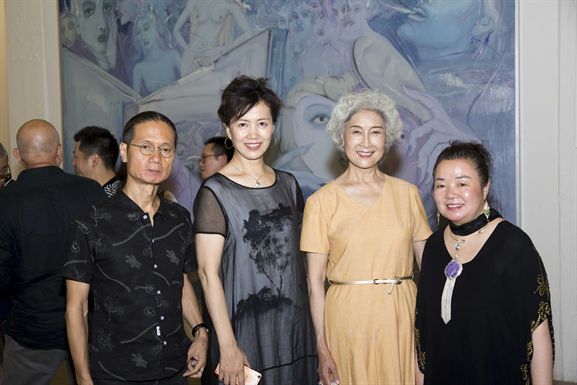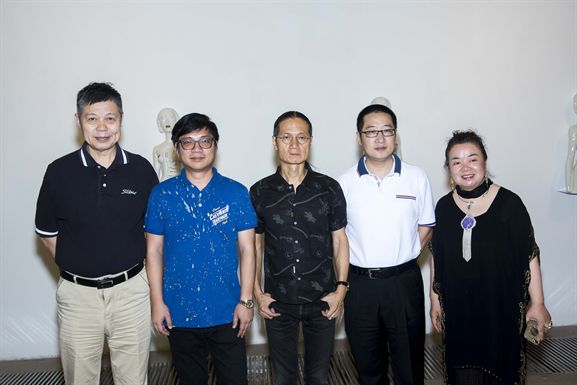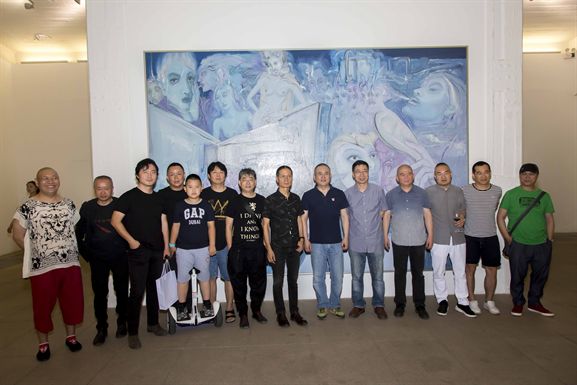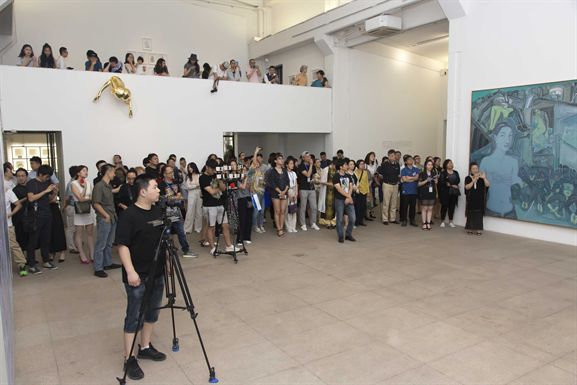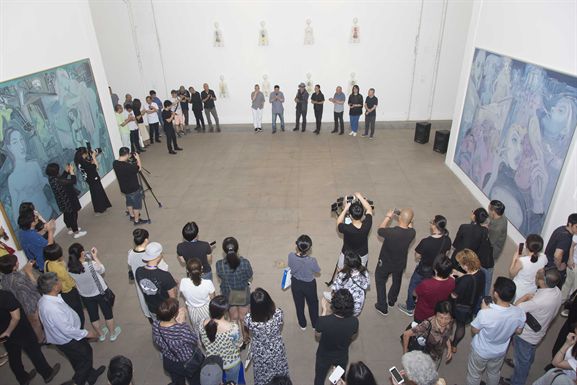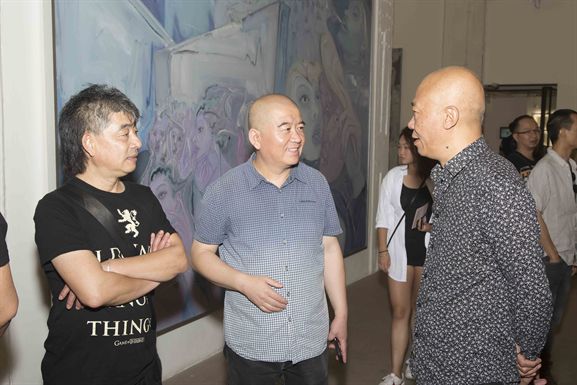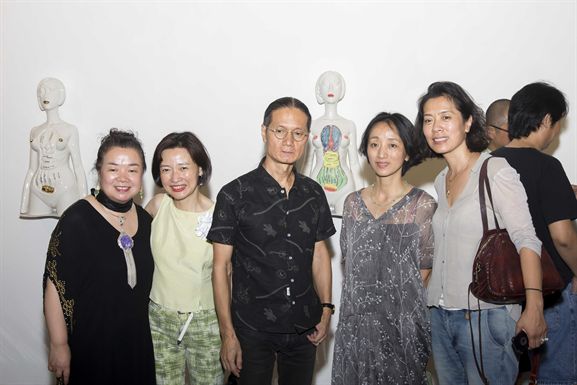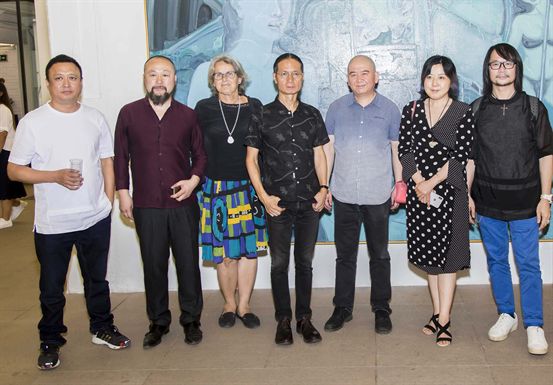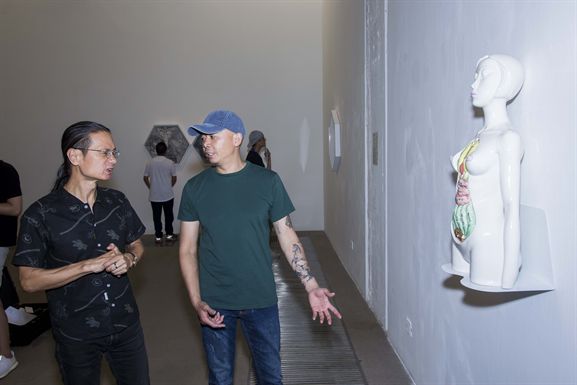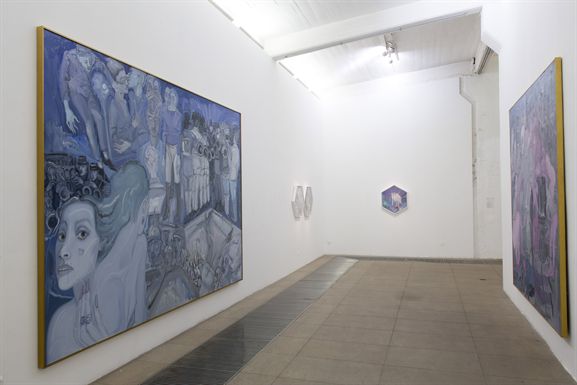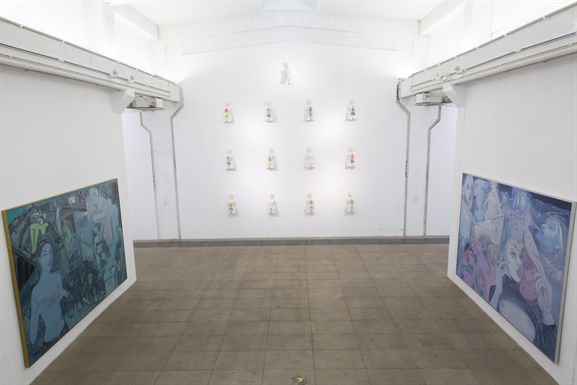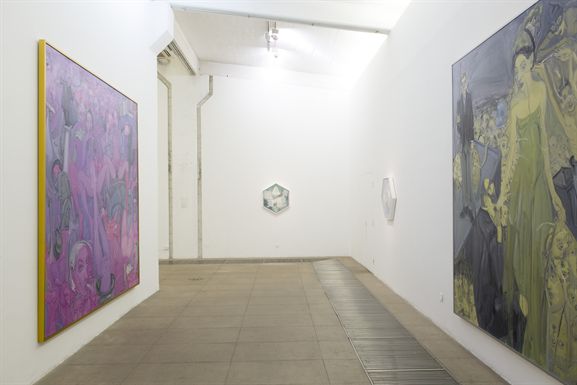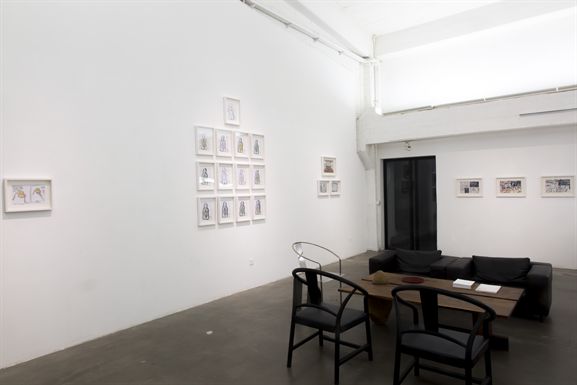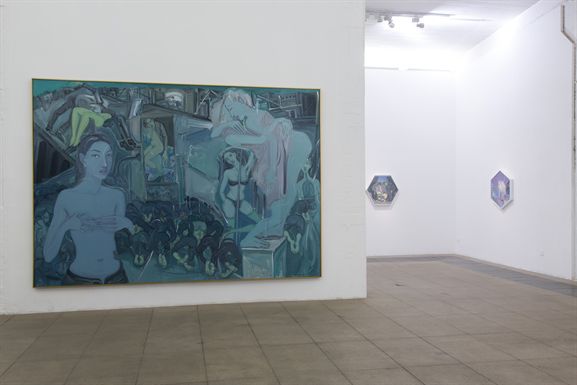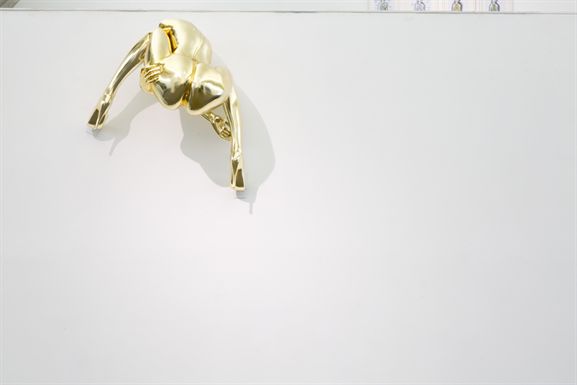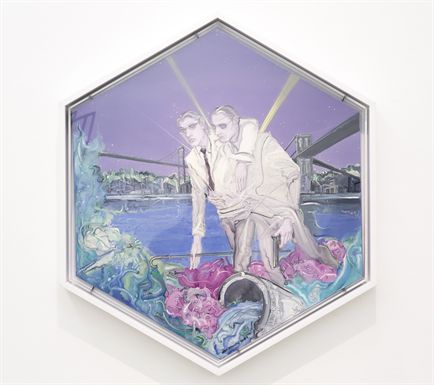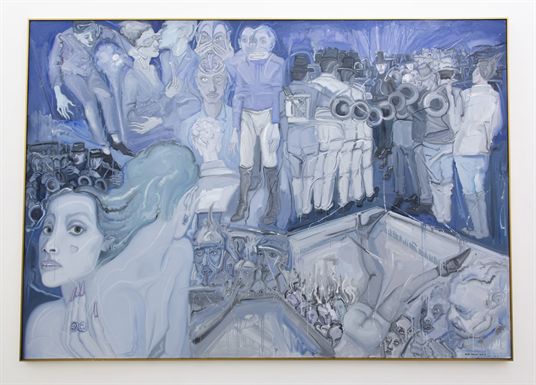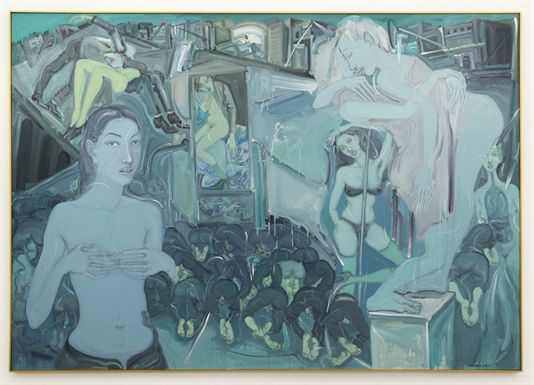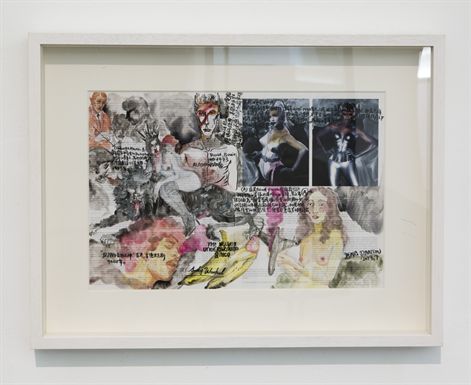Jun 16 - Jul 22, 2018
Press Release
Whitebox Art Center is pleased to announce that Untruth: Deng Jianjin’s Solo Exhibition will open on June 16, 2018. Curated by Ji Shaofeng, this exhibition is the first-ever collaboration between Whitebox Art Center and artist Deng Jianjin. The Exhibition will showcase some ten artworks by Deng during 2012 to 2018. Combining White Box’s unique space and the spiritual dimension in Deng Jianjin’s works, Untruth will bring to you the artist’s sincere thoughts and passionate expressions toward the rapidly-changing realities in our contemporary society.
Deng Jianjin is an artist dedicated to “Body Narratives.” With his clustering and description based on the main lines from urban plots to relationships between men and women, violence, eroticism, desires, and group consciousness, Deng expresses those secret emotions of humans using body symbols. Through these signs and expressions of bodily taboos, Deng Jianjin also explores a kind of power awareness. Looking back at his past oeuvres, we could not find any standardized language of oil painting but his inner impulse to the narration in an attempt to focus on body and then decompose it, shaping Deng’s uniqueness of creative form. Especially for Untruth: Deng Jianjin’s Solo Exhibition, the artist once again borrowed the notion of “body” and hence finished his newest work My Girl. This piece of art is consisted of 12 half-naked women made of Blanc-de-Chine and is neatly arranged on the wall of the main exhibition hall. Deng Jianjin has engraved erotic words on the white porcelain women’s dissected organs and has placed “himself” as a sleeping man inside “uterus,” making it a sharp contrast between the faces of these female characters with teardrops and dazed emoticons. In a time when people are ashamed to talk about erotics, Deng Jianjin dares to face up to this taboo. Straightforwardly, Deng makes an inevitable compromise to the reality of survival and desire. It is also his revolt against pressure, which shows the autocratic domination of desire, the dominance of reason over the body, and the dominance of patriarchal power over women.
Deng Jianjin believes that original sin and principal crime stemmed from the body and that they are carried out by this cage of the soul. Therefore, after his urban-plotted paintings, Deng gradually emphasizes those bodily narrative traits and erotic features of his works. In his paintings, absurd scenes, distorted bodies, and dissonant background colors make the women fragile and sensitive; More than these, erotic bodies in Deng’s works are fresh yet virtual, serving as the lives been pondering, as well as a real expression of individual experience. Only this expression is a kind of psychological truth, and it is a real transformation from the reality of the mind to the reality we live in, and the facts of life as well. Moreover, It is the authentic expression packed with the virtual experience, extreme personal experience, and concealment.
Curator Article
The Truth of Life — Reading Deng Jianjin's Paintings
Ji Shaofeng
When you first met Deng Jianjin, you will be stunned by his world of visual images, which inside lays nothing more than erotics flooding with desire, struggle, and anxiety. The second encounter with the artist, however, a kind of sincere thought and passionate expression toward the cataclysm in our contemporary society have been highlighted as more than erotics, even though " erotics" is still the motif for Deng's visual narratives.
To talk about Deng Jianjin, we must put him together with the social upheaval of the 1990s. Only when we re-construct historical context can we know Deng's path of visual expression. Moreover, the meaning of Deng Jianjin lies in that, in his works, those markings of personalized bodies and erotic symbol narratives not only reflect the changes in lifestyle and artistic expression incurred by the radical changes in social, political and cultural structures, but, with his unique explorations in visual spirit, Deng Jianjin has also had a remarkable position in the course of the development in Chinese contemporary art history.
One undeniable fact is that Deng Jianjin is an important member of the "new generation" artists in the early 1990s. His world of visual images highlights an agile response to the emergence of urban culture, the prevalence of pop culture, and the rapid transformation from the pre-modern to post-modern society. Viewing only from Deng's choice of theme, we have been able to sense that this is a transformation where he bids farewell to "Rural Realism", as well as a shift of themes from the rural ones to the urban ones concerning the realities of survival; it is also about an era in which market economy replaces planned economy and the about-turn right after Deng Xiaoping's The 1992 Speech in Southern China. On the heels of such beginning are phenomena as confusions in state of mind, disappearance of political idols, the rise of Capitalism, the fall of ideals and values, the loss of the (Socialism) Collectivist experience and the Heroism Tradition and Belief, and a conversion from the ultimate concern to the reality one, as what Yi Ying writes in Striving for Definite Meanings:
The "new generation" artists are the first ones to dissolve those obscure and foggy feelings in the artworks of the 1985 period. They represent their ways of life in a straightforward manner. Viewers will not face any difficulties of interpretation when appreciating these paintings by the "new generation" artists. It is for this reason that stands out the meanings of these works, and that it has a sense of coldness and boredom coming out from those daily-life themes the "new generation" artists have chosen. The sense of responsibility and rational spirit being upheld since the 1985s have disappeared without a trace, which marks the loss of social beliefs and central values, making it a hidden theme as no-ideals, no-beliefs, and no-pursuit within the "new generation" paintings. (Yi Ying: The Downfall of Academy, Hunan Fine Arts Publishing House, 2001, Page 25)
With context above, it is not difficult to understand why days of youth, life, sexuality, violence and collective awareness have always become the main plots in Deng Jianjin's visual expression. Readers of Deng's paintings can also sense that a kind of uncanny power—the force of anxious realities of survival and life experiences, the hunt for psychedelic and intense feelings, the fetish of body, violence, erotics, madness, and sexual impulses—unleashed from those works. Such readings can also be found in the artist statement by Deng Jianjin:
As a result, through the cultural choice and the irrational concept, I see a series of faces among society, power, and sex. Behind the developments of the industrial revolution and electronic revolution, there is a negative impact, a phenomenon of alienation of human nature. Neither the bloom of today's society nor the fast development of computer technology can resist or eliminate the eagerness people deeply have for communication and trust, as well as the psychological and practical problems caused by loneliness and pressure. (Deng Jianjin: Visual Experience in Virtual Transformation—Choice and Simulation of Schema Concerning" Attempted Crimes," excerpted from the monograph Deng Jianjin: Lust, Taboo, Chinese Artists Press, 1e, published in January 2009, Page 321 )
Obviously, Deng Jianjin has found his way of visual expression, while behind his choice of erotic symbols is his active selection, where sexuality is primitive, and erotics civilized. Through the expression of these suggestive symbols and physical taboos, Deng is actually exploring the awareness of power. His visual expression of erotic bodies serves as a real expression of individual experience, which its trait being fresh and virtual, and which its essence being a living body reflected by the artist. It is a real transformation from the reality of the mind to the reality we live in, but it is indeed a reality of life. It is also a real expression of virtual experience riddled with extreme personal experience and concealment.Under Deng Jianjin's rational inspection, absurd scenes, unbearable chaos, sensuality-filled texts and sex symbols, wild colors, and nomadic lines are all igniting readers' fire of desire, at the same time inviting viewers to a thrilling preview, in a profound, flooded yet confrontational way showing onlookers a real face deep inside humanity. What is special about all these is that Deng Jianjin has told the truth that most are ashamed to talk about sexual taboos. Through his outspokenness, it can be observed that Deng has shown us his inevitable compromises under pressures of survival. His compromises can be seen as the escape from the institution, his compromises as in defiance of discipline and rules, plus in resistance to pressures imposed by the institution. What is more revealing in his artworks is the dictatorship of despotism, the dominance of reason over the body, and the dominance of patriarchal power over women.
In pace with conveying the truth about the depths of human nature, Deng Jianjin's visual expression is also a struggle for him to get rid of control. He delivers readers a strong sense of the present, the contradictions, and the confusions brought about by urban consumer society, namely his subjective reactions to the transformation from the pre-modern to post-modern society. In between these visual images are the mentally ills' world as intense, chaotic, and obscene, together with sexual impulses as primitive, instinctive, and biotic; they form up a string of stunning, theaterized realities with illusion, irritation, violence, and erotics. These visual landscapes are not the reality Deng Jianjin lives in, but the artist's simulated scenes of erotics seen from Deng's individual experience and secretiveness. Coincidentally, the repressed freedom of human beings, as with the repressed pursuit of free lifestyles, is nothing but another kind of metaphor hidden between images; at the same time, it is a phenomenon as split humanity walking between reality and transiency, where experience from the sense of guilt and desire had never taken place. Deng jianjin does hope that this virtual experience had never happened, but what has happened in the urban society—a sensory world full of sleepwalking-like records, fragmented realities, and scenes filled with splendour, adventure, lust, anxiety, illusion, sex, power, passion, speed, and violence.,etc—such endless views exist both inside reality and non-reality. Through his passionate yet dreamy narratives, Deng jianjin guides his readers, step by step, into the elaborative labyrinth he directs and designs.
This is the Deng Jianjin integrated into the metropolis with youth and passion, dream and confusion; this is the world of reality rejected by Deng's mind in itself. In his dream-like recounts, Deng Jianjin builds a space containing scenes of psychedelic erotica, a mentality as "playing with life," extreme loss and disappointment, as well as the body-soul contradictory between happiness and suffering. The same straightforwardness in nudes as that from the naked souls in his paintings, Deng Jianjin directly pours his true feelings in between images and bodily markings. Therefore, when touching the secrets lying under representations of life, Deng's art simultaneously reflects the visual experience under the condition of popular culture in a post-industrial civilization period, and at the same time reveals people's anxieties toward survival and their unfulfilled desire, which, in other words, the temptation and fantasy of sex in a consumerism era where popular culture runs rampant. By such a frank way of expression in his visual space, Deng Jianjin tells us that sex is beautiful, but fragile and precarious at the same time.
Sometimes, Deng Jianjin will be completely immersed in the dreamy world he creates, and this trace of visual expression and logic of visual narratives can be peeped through the naming of many of his works: Why The Setting Sun Makes Us So Beautiful, A Repertoire for a Kinky Giddiness Maker (No.8), The Creamy Love, The Lovebirds Being Shown Off, A Delusional Scenic Boundary by an Onlooker,and Lunatic Folks Babbling to Luna(No.4)
Without a substantial amount of readings, it can be challenging for Deng Jianjin to name his paintings as such. In daily life, Deng Jianjin does have the same qualities as poets and literary youth. He is even more obsessed with pop music, such as his fanaticism about Teresa Teng and her songs; he read books of psychopathological analysis of sexual metamorphosis, psychology, and philosophy. Apparently, in his adolescence, he who did not read a few books by Schopenhauer and Freud was not" artistic" enough, which also led to Deng Jianjin's unique visual spirit. However, with a meticulous visual scheme, and expression of his visual persistence of more than 30 years, Deng Jianjin dedicates to an effective unification of the blend of absurdity as "id" and "nonego", "the real" and "the unreal", "rationality" and" irrationality",as well as "logic" and "non-logic". Deng Jianjin has stripped down human-made hypocrisy, and hence unearthed a true state of human life. However, the "true state" here is not "true" reality; it is, in fact, Deng's "middle ground" with a conversion from imaginary space and psychological reality to visual reality—in other words, a summoning of life, a living dilemma in the gap between reality and non-reality.
As a witness and writer of culture in the ever-changing development of contemporary arts, Deng Jianjin utilizes lonely yet alternative visual spirit appeal, personal experience, and real expression, from one side,reflects the profound changes in the political, economic and socio-cultural structure of Chinese society after the country entered the market economy era in the 1990s. Deng especially mirrors that, in such a time, people's experience in survival and anxiety—a combination of passions and dreams packed with brutalities and taboos, with helplessness, illusion, and delusion of reality in the meantime. They seem not to be mainstream, orthodox and noble thoughts, but they instead represent specific levels of contemporary Chinese culture and people's perplexity of today.
Therefore, readers saw a "timeless" Deng Jianjin, an artist who keeps bringing them visual surprises and new expectations. Meanwhile, they saw that Deng has continuously translated his expression from psychological reality to visual reality. Thus, they have even understood that Deng Jianjin's visual space of the real, transformed from the imaginary space to the urban fact, reveals the truth of life, the satisfying imagination of the desire, and the individual experience of the body; they arise from the transition from body symbols to body politics. Together with the desperate reliance on desire and excessive consumption, and with the predicament as the loss of morality, heroism, and belief, readers of Deng also saw the reality of survival we have to face. Finally, just as Sigmund Freud puts it in his autobiography:
Obviously, the kingdom of imagination is, in fact, a shelter. The reason why this shelter exists is that people have to give up some instinct requirements, so they have to painfully retreat from the "pleasure principle" to the "reality principle." This shelter is built in such a torturous process. Therefore, an artist is like a mentally ill, moving back from a reality he dislikes and then delving into a world created by his imagination and creativity. However, artists are different from the psychiatric patients because artists know how to find their way back to the reality and then harness it. His artworks, same as his dreams, are the hypothetical fulfillment of his unconscious desire. In essence, works of art have the same compromises as that of dreams, as both of them have to avoid the head-on collision with the force of repression. ( Sigmund Freud, On Aesthetics: An Anthology, translated by Zhang Huanmin and Chen Weiqi, Knowledge Publishing House, 1987, Page 10)
Written in Sanguandian, Donghu at 10:25 pm, May 8, 2018
Installation View
Artworks
- “My Girl”NO 1-NO 13 Blanc-de-Chine 37 x 17cm 2018
Media Report

